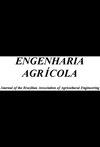咖啡果柄系统的振动传递性:高频瞄准机械采收的强制振动研究
IF 0.9
4区 农林科学
Q3 AGRICULTURAL ENGINEERING
引用次数: 0
摘要
本文章由计算机程序翻译,如有差异,请以英文原文为准。
VIBRATION TRANSMISSIBILITY OF THE COFFEE FRUIT-PEDUNCLE SYSTEM: A FORCED VIBRATION STUDY OF HIGH FREQUENCY AIMING MECHANICAL HARVESTING
Semi-mechanized and mechanized harvesting use machines that promote the transference of vibrational energy and impact to achieve the detachment of coffee fruits. The aim of this study was to evaluate the vibration transmissibility in coffee fruit-peduncle systems, using high-speed cameras, submitted to high frequency harmonic excitation in different combinations between frequency and amplitude of vibration, identifying working ranges suitable to perform selective harvesting. Vibration transmissibility was determined for the coffee fruit-peduncle systems, for the maturation stages unripe and ripe that were subjected to a sinusoidal harmonic displacement, in which the input parameters were frequency (35, 45 and 55 Hz) and peak-to-peak amplitude (3.5, 5.0 and 6.5 mm). An experiment was used to study the effect of frequency and amplitude on vibration transmissibility in a completely randomized design in a factorial scheme 3 x 3 x 2, with three replications. The frequency of 35 Hz, associated with the amplitudes 3.5-6.5 mm, was the one that most influenced the results of vibration transmissibility. For the frequency of 55 Hz and amplitude of 6.5 mm, in the ripe maturation stage, the vibration transmissibility was higher than 1.0, which could be a suitable combination for selective coffee harvesting.
求助全文
通过发布文献求助,成功后即可免费获取论文全文。
去求助
来源期刊

Engenharia Agricola
AGRICULTURAL ENGINEERING-
CiteScore
1.90
自引率
20.00%
发文量
62
审稿时长
4-8 weeks
期刊介绍:
A revista Engenharia Agrícola existe desde 1972 como o principal veículo editorial de caráter técnico-científico da SBEA - Associação Brasileira de Engenharia Agrícola.
Publicar artigos científicos, artigos técnicos e revisões bibliográficas inéditos, fomentando a divulgação do conhecimento prático e científico na área de Engenharia Agrícola.
 求助内容:
求助内容: 应助结果提醒方式:
应助结果提醒方式:


